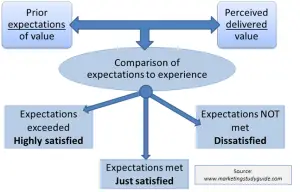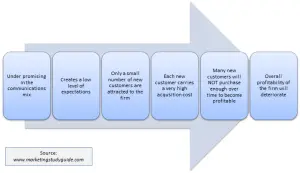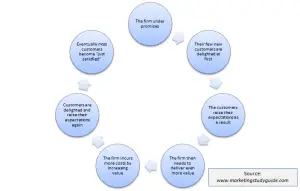Don’t Under-promise and Over-deliver!
It’s a common cliché to under-promise and over-deliver, which even some marketing consultants and professional speakers have tended to suggest. The problem with this approach is that it is based on a very simplistic understanding of the customer satisfaction model and is a very poor strategic choice for a firm.
Let’s start at the beginning, which is the way that consumers determine their level of satisfaction. It is simply the comparison of their pre-purchase expectations against the level of value that they actually received, as highlighted in the following model. (Please note that there are several sections on this website that discuss the concept of customer satisfaction in far greater depth – start with the section on understanding customer satisfaction.)

(Click to enlarge)
Therefore, there initially appears to be an element of logic to the old under-promise and over-deliver statement as the basic model of customer satisfaction suggests that the outcome should be a lot of highly satisfied customers. However, there are two problems with this logic – high customer acquisition costs and short-term customer satisfaction effects.
High customer acquisition costs
If a firm under-promises (which would be achieved by communicating through its promotional mix that it offers a fairly low level of benefits) then it will have the effect of:
- Dramatically reducing the number of new customers attracted to the firm and its products,
- Which has the impact of dramatically increasing new customer acquisition costs (that is, the promotional and other costs associated with gaining a first-time customer),
- Which in turn may mean that each customer may not purchase enough from the firm to be profitable, and
- If a firm has lots of unprofitable customers, then the firm overall is far less likely to be profitable.
This relationship is highlighted in the following model showing the under-promise and over-deliver fallacy.

(Click to enlarge)
Supporters of this under-promise and over-deliver cliché will argue that although you have a much smaller number of new customers, they will be delighted (highly satisfied) with the firm and start telling their friends, have greater loyalty, and generally purchase more (see the section on benefits of customer satisfaction). However, they have failed to consider the short-term customer satisfaction effects, as discussed in the section below.
Short-term customer satisfaction effects
The second problem with under-promising and over-delivering is the fact that customer’s expectations are not static – they change and modify with each encounter and/or purchase with the firm.
(Please see the discussion of how customer satisfaction evolves in a separate section for further information.)
Even customers who start out delighted (highly satisfied) will rapidly progress to “just satisfied” over time and with further experiences with the firm. This occurs naturally because the customer’s expectations will be increased.
As a simple analogy example, if a child normally gets $5 per week pocket money and then one week they get $20 – then in that week they will be delighted. However, if from then on they continue to receive $20 per week, they will come to expect that amount and will become just satisfied with $20.
The same thing happens with customers – for customers to remain delighted (highly satisfied) then the firm needs to constantly deliver more value to the customer, because their expectations will keep increasing. Therefore, as highlighted in the following diagram, this becomes a never-ending cycle, which means that the firm cannot expect to have lots of delighted customers – most of them will be “just satisfied”.

(Click to enlarge)
Therefore, because there is no long-term benefit of customer satisfaction being generated from under-promising and over-delivering, and because it limits new customer growth and drives up new customer acquisition costs – it is a strategy that is generally best avoided – the preferred approach would be to build reasonable expectations in order to attract a greater number of new customers.
